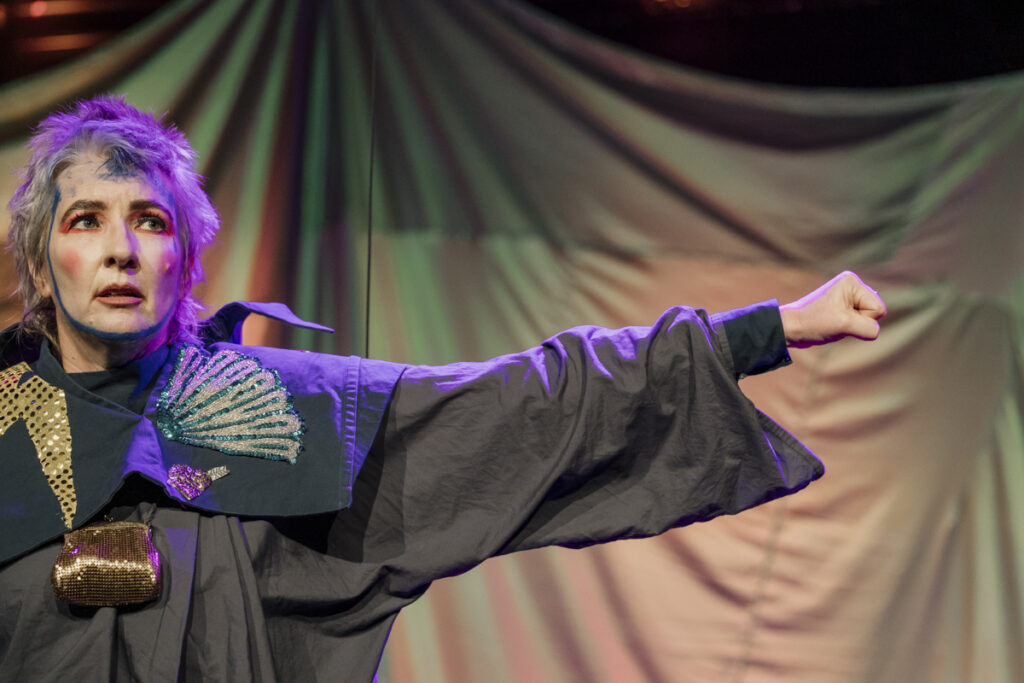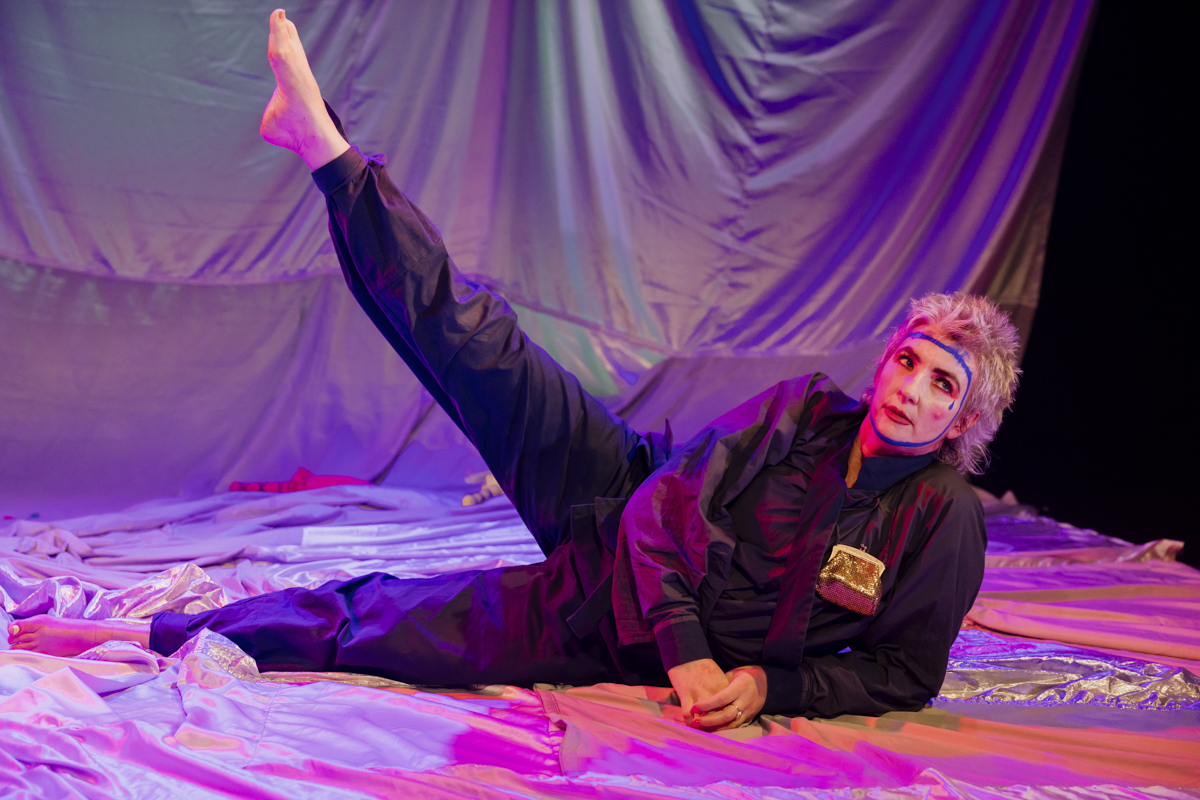Jo Randerson is a beloved titan of theatre. We know this. When I lived in Jo’s homeground of Te Whanganui-a-Tara, they were discussed constantly – the importance of their mahi, the tools they implemented, the generosity of their spirit. Banging Cymbal, Clanging Gong changed how I saw theatre, and so I always viewed Jo with reverence, thought of them as a sort of theatre god, when in fact what makes Jo so special to me is that they are deeply human.
What does it mean to be human, though? Humans are all sorts of things; do we really have that much in common? I think the answer lies somewhere in this 75-minute piece (“Maybe more like 85-90,” Jo tells us, winking). Speed Is Emotional is a show about ADHD. Jo was diagnosed with ADHD in their 40s, alongside their son. We join Jo inside their chaotic, creative mind as they navigate life and parenting with the disorder. Jo asks many times along the way if their behaviours are “an ADHD thing or a human thing?” And to be honest, I couldn’t tell you.
My autism asks me its own version of this question many times a day—is it an autism thing or a human thing that I need 48 hours’ notice of even a small change in plans? Is it an autism thing or a human thing that I have been watching the same TV show on loop every day for the last 10 years? Is it an autism thing or a human thing that I don’t find jokes funny unless they make literal sense? As you might be able to glean, the answer is very typically the former (and to ask that question means I kind of already know the answer anyway).

It’s genuinely so thrilling to see performers embrace their neurodiversity onstage, and I can imagine it to be such a relief for Jo not to have to mask. Those of us on the spectrum (50-70% of people with ADHD are also on the autism spectrum and vice versa1) are often praised for some aspects of our conditions, but scolded for the others. It’s confusing. You’re sensitive, but you need to not take things so deeply. You’re clever, but you’re too fast. You’re creative but just too particular. But our desired traits come hand-in-hand with our undesired ones. And Jo’s right—speed IS emotional.
Being asked to slow down all the time is an emotional experience when that speed is part of who you are, part of what makes you unique. Jo finds it difficult to slow down, especially when being asked. The world is already too slow for them. Their speed allows them to be fully present onstage, and since we’re lagging behind anyway, they may as well run for it—and they do. You trust Jo, even if you can’t see where you’re going, even if you can’t hear above the music. You trust them to find their way back to moments of stillness with us, however fleeting. You treasure those moments, rest in them until Jo sweeps you away again.

As I’m sure you can see, neurodiversity and accessibility in theatre are on my mind a lot, particularly because no theatres in Tāmaki Makaurau really practice accessibility consistently. Seats are tiny and squished too close together, which also leads to the blocking of sightlines. Masks and hand sanitiser stations have all but disappeared (except for the occasional rogue bottle that hasn’t been refilled since 2021). Tickets to shows are more expensive than they’re ever been. And despite every showing of Speed Is Emotional being described as a ‘relaxed performance’, there are no NZSL-interpreted or audio-described sessions planned.
Sure, there’s a breakout space available outside the theatre for anyone experiencing overstimulation, but there’s also a bathroom with four walls that I can hide in where nobody will actually see me, or I can just go downstairs and out into the fresh air. When investments are made into only the easiest and least risky parts of accessibility, it makes me wonder who this is all for, then? I would love to see Q Theatre, in particular, push to make more accommodations for disabled audiences and to encourage their artists to do the same. We can’t be what we can’t see, and we can’t see if the sightlines are blocked.
I’m not always stoked to read reviews where the author doesn’t talk much about actual stage moments and talks about themselves instead, but I can’t really help it here. This show is personal, the layout so familiar. It can be confronting to see a mind similar to yours play out on the stage, even more so when everyone around you is laughing. It left me feeling quite vulnerable, but I felt safe, too, knowing that it wasn’t about me—it was about this brave performer letting us in, letting us trust them, laugh with them and love them.

All that being said, I would rewatch this performance in a heartbeat, if only to feel the glass break again—that moment when a performer expresses something so vulnerable and strange and true, and you feel so seen, almost too much so. Those moments are for me, and they stay close to my heart. It’s not something that happens all the time in theatre (at least not for me), and I think THAT’S the deeply human aspect to Jo Randerson—that they can make you feel that way multiple times a show, and then later that week when you’re drinking coffee or writing an art response. So, is Speed Is Emotional an ADHD thing or a human thing? Reader, it is decidedly, lovingly, achingly, painfully, wonderfully both.
Speed is Emotional is presented by Silo Theatre in collaboration with Barbarian Productions and is showing at Q Theatre until Saturday 3 May. Tickets are available from Q Theatre.
Created by Jo Randerson
Directed by Isobel MacKinnon
Design by Kaleb Maunder, Bekky Boyce, Steven Junil Park and Elliot Vaughan
Performed by Jo Randerson and Elliot Vaughan
- Hours, C., Recasens, C., & Baleyte, J. (2022). ASD and ADHD Comorbidity: What Are We Talking About? Frontiers in Psychiatry, 13. https://doi.org/10.3389/fpsyt.2022.837424 ↩︎
Featured images by Andi Crown Photography, courtesy of Silo Theatre.



